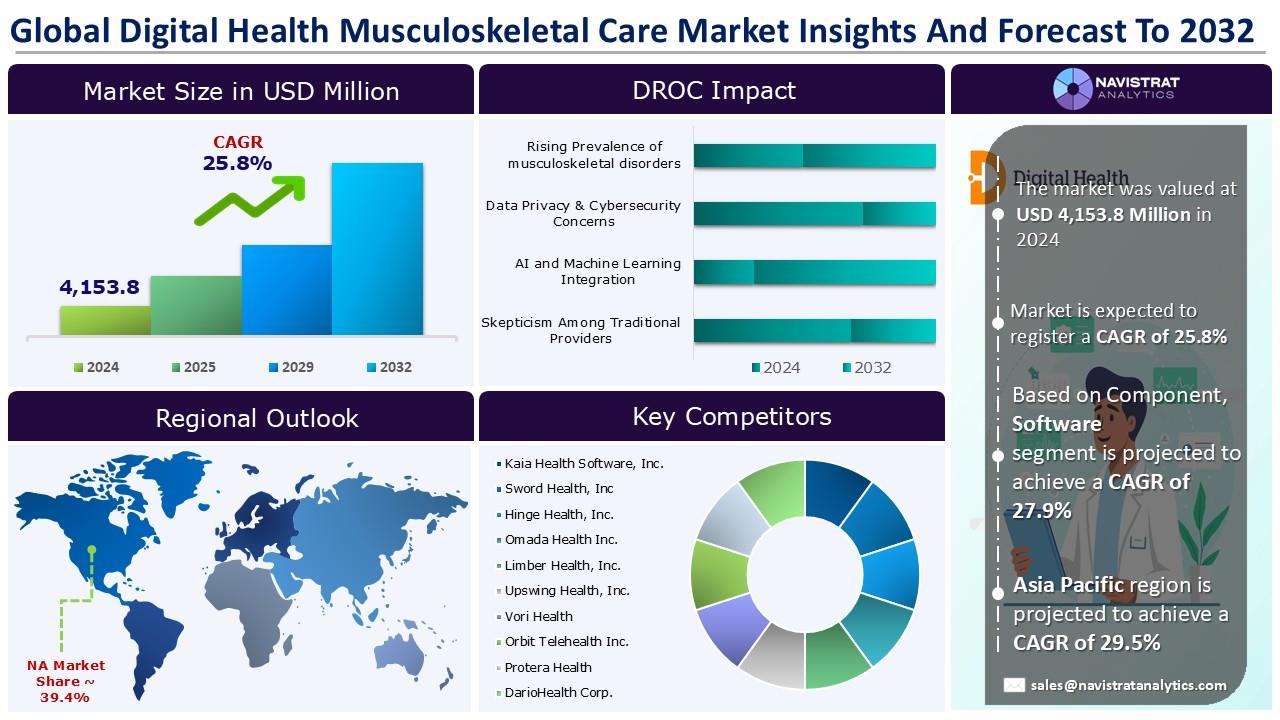Science
Digital Health Musculoskeletal Care Market to Hit USD 26.2 Billion by 2032

The digital health musculoskeletal care market is projected to reach USD 26,165.0 million by 2032, driven primarily by the rising prevalence of musculoskeletal disorders worldwide. According to the World Health Organization (WHO), approximately 1.71 billion people globally suffer from these conditions, with significant variations by age and diagnosis. In industrialized nations, around 441 million individuals are affected. The WHO’s Western Pacific region accounts for 427 million cases, while the South-East Asian region has about 369 million cases.
The issue is particularly acute among older populations, with nearly 40% of individuals over the age of 60 experiencing musculoskeletal problems. Additionally, approximately 80% of this demographic reports suffering from low back pain. In response to this growing crisis, Hinge Health recently launched the Hinge Health Global platform, which aims to address chronic pain in the global workforce through personalized digital care solutions.
Innovative Solutions and Market Challenges
Hinge Health Global offers a comprehensive suite of digital treatments designed for multinational companies, including individualized care plans and full-body treatment programs. These resources provide instant access to care through a single platform, improving the delivery of musculoskeletal support. Despite these advancements, challenges remain, particularly concerning data privacy and cybersecurity, which could impede market growth.
Encouraging patients to consistently use wearable devices is another hurdle. Factors such as device comfort, usability, and patient education significantly influence adherence. Many patients struggle with regular usage or accurately interpreting the data, which can diminish the effectiveness of continuous monitoring solutions.
The digital health musculoskeletal care market is segmented into software and services, alongside hardware. The software and services segment has shown the highest growth rate, largely due to advancements in commercial artificial intelligence (AI) and deep learning. These innovations enhance various stages of the patient journey, from pre-visit triage to clinical workflows, improving diagnostic imaging and surgical planning. Additionally, digital therapeutics are emerging, aiming to enhance rehabilitation outcomes.
Regional Insights and Competitive Landscape
In 2024, North America captured the largest market share for digital health musculoskeletal care. This growth is propelled by increasing demand for telehealth and virtual physical therapy services. The National Safety Council (NSC) reported that exercise equipment was responsible for the highest number of sports and recreation-related injuries in 2023, with approximately 482,886 cases recorded. Furthermore, the Centers for Disease Control and Prevention (CDC) indicates that over 2.5 million adolescents and teenagers visit emergency rooms annually for sports-related injuries.
The competitive landscape of the digital health musculoskeletal care market is fragmented, with numerous players holding significant market shares. Major companies include Kaia Health Software, Inc., Sword Health, Inc., and Omada Health Inc., among others.
Recent strategic developments highlight the ongoing evolution within the sector. In April 2025, Stance Health, a company focusing on musculoskeletal care, secured USD 1 million in pre-seed funding to enhance its technology-enabled care model in India. This funding round was led by General Catalyst and included contributions from investors such as Antler and DEVC. Additionally, Hinge Health announced a collaboration with Cigna, which allows clients access to its digital platform for on-demand musculoskeletal care from any location.
Navistrat Analytics has categorized the digital health musculoskeletal care market by component, solution, delivery mode, indication, end-use, and region, highlighting the diverse opportunities and challenges present in this expanding field.
As the market progresses, the integration of innovative technologies alongside the increasing demand for effective musculoskeletal care solutions will likely shape the future landscape, making it an area of significant interest for healthcare providers and investors alike.
-

 Lifestyle3 months ago
Lifestyle3 months agoHumanism Camp Engages 250 Youths in Summer Fest 2025
-

 Sports3 months ago
Sports3 months agoDe Minaur Triumphs at Washington Open After Thrilling Comeback
-

 Business4 months ago
Business4 months agoKenvue Dismisses CEO Thibaut Mongon as Strategic Review Advances
-

 Sports4 months ago
Sports4 months agoTupou and Daugunu Join First Nations Squad for Lions Clash
-

 Top Stories4 months ago
Top Stories4 months agoColombian Senator Miguel Uribe Shows Signs of Recovery After Attack
-

 World4 months ago
World4 months agoASEAN Gears Up for Historic Joint Meeting of Foreign and Economic Ministers
-

 Business4 months ago
Business4 months agoOil Prices Surge Following New EU Sanctions on Russia
-

 Health3 months ago
Health3 months agoNew Study Challenges Assumptions About Aging and Inflammation
-

 Entertainment3 months ago
Entertainment3 months agoDetaşe-Sabah Violin Ensemble Captivates at Gabala Music Festival
-

 Entertainment3 months ago
Entertainment3 months agoBaku Metro Extends Hours for Justin Timberlake Concert
-

 Business4 months ago
Business4 months agoU.S. House Approves Stablecoin Bill, Sends to Trump for Signature
-

 Top Stories4 months ago
Top Stories4 months agoRethinking Singapore’s F&B Regulations Amid Business Closures









